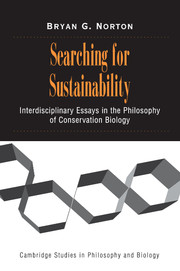Book contents
- Frontmatter
- Contents
- Searching for Sustainability
- General Introduction: An Interdisciplinary Experiment
- I PRAGMATISM AS AN ENVIRONMENTAL PHILOSOPHY
- II SCIENCE, POLICY, AND POLICY SCIENCE
- III ECONOMICS AND ENVIRONMENTAL SUSTAINABILITY
- IV SCALING SUSTAINABILITY: ECOLOGY AS IF HUMANS MATTERED
- 15 Context and Hierarchy in Aldo Leopold's Theory of Environmental Management
- 16 Scale and Biodiversity Policy: A Hierarchical Approach, with Robert E. Ulanowicz
- 17 Ecological Integrity and Social Values: At What Scale?
- 18 Change, Constancy, and Creativity: The New Ecology and Some Old Problems
- 19 Democracy and Sense of Place Values in Environmental Policy, with Bruce Hannon
- V SOME ELEMENTS OF A PHILOSOPHY OF SUSTAINABLE LIVING
- VI VALUING SUSTAINABILITY: TOWARD A MORE COMPREHENSIVE APPROACH TO ENVIRONMENTAL EVALUATION
- Index
- References
19 - Democracy and Sense of Place Values in Environmental Policy, with Bruce Hannon
Published online by Cambridge University Press: 21 January 2010
- Frontmatter
- Contents
- Searching for Sustainability
- General Introduction: An Interdisciplinary Experiment
- I PRAGMATISM AS AN ENVIRONMENTAL PHILOSOPHY
- II SCIENCE, POLICY, AND POLICY SCIENCE
- III ECONOMICS AND ENVIRONMENTAL SUSTAINABILITY
- IV SCALING SUSTAINABILITY: ECOLOGY AS IF HUMANS MATTERED
- 15 Context and Hierarchy in Aldo Leopold's Theory of Environmental Management
- 16 Scale and Biodiversity Policy: A Hierarchical Approach, with Robert E. Ulanowicz
- 17 Ecological Integrity and Social Values: At What Scale?
- 18 Change, Constancy, and Creativity: The New Ecology and Some Old Problems
- 19 Democracy and Sense of Place Values in Environmental Policy, with Bruce Hannon
- V SOME ELEMENTS OF A PHILOSOPHY OF SUSTAINABLE LIVING
- VI VALUING SUSTAINABILITY: TOWARD A MORE COMPREHENSIVE APPROACH TO ENVIRONMENTAL EVALUATION
- Index
- References
Summary
An important problem of modern society is to understand how constraints on resource use can be democratically imposed. Recent authors have expressed deep concern about the possibility that resource shortages will lead to totalitarian governments. They hypothesize that such governments would be the only effective means to enforce constraints on resource use and protect the environment from the inevitable consequences of human population growth, overconsumption of natural resources and social chaos (Hannon 1985; Heilbroner 1974; Kennedy 1993; Ophuls 1977, 1992). Ludwig et al. (1993) have provided an elegant argument – based in fisheries management but apparently susceptible to startling generalization – which calls into question the ability of democratic governments with free market economies to protect renewable resources once there has been heavy capitalization and development of exploitative industries. Must societies of the next millennium be undemocratic if they are to protect their natural resources?
In this paper we address one important aspect of the search for a democratically supportable policy that will sustain resources for future generations – the comparative role of national/centralized, regional/state, and local communities in the development of environmental policy. We distinguish two approaches to the evaluation, development, and implementation of policies to protect resources and environments. The two approaches (we will call them “top-down” versus “bottom-up”) differ most essentially in that the top-down approach emphasizes centralized control and decision making, while the bottom-up approach attempts to protect, to the extent possible, local prerogatives in setting environmental policy.
- Type
- Chapter
- Information
- Searching for SustainabilityInterdisciplinary Essays in the Philosophy of Conservation Biology, pp. 345 - 372Publisher: Cambridge University PressPrint publication year: 2002



